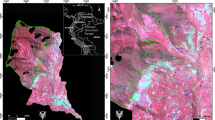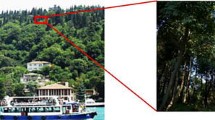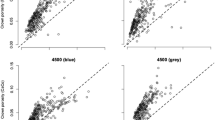Abstract
Information about forest biodiversity has so far been collected mostly by using field inventories, but it is desirable to find other methods that can cover large areas at a lower cost. In a forest landscape covering 2000 ha in southern Sweden we tested if colour-infrared (CIR) aerial photographs on the scale of 1:30000 can be used to interpret forest stand characteristics correlated to the occurrence of epiphytic lichens that are Red-listed or otherwise indicate high nature conservation value (‘signal species’). Using logistic regression we found that the interpreted stand variables tree height and crown structure class were significantly correlated to the occurrence of Red-listed species. For signal species, the variables tree height, percentage of southern deciduous trees and crown structure class were significantly correlated to the occurrence. The logistic regression models successfully predicted a significantly higher probability to find Red-listed species in the stands that actually contained such species compared to stands without Red-listed species. The same was true for stands with signal species. We conclude that interpretation of CIR aerial photographs could be a useful method to find certain groups of epiphytic lichens in surveys covering large areas.
Similar content being viewed by others
References
Ahti T., Hämet-Ahti L. and Jalas J. 1968. Vegetation zones and their sections in northwestern Europe. Annales Botanici Fennici 5: 169–211.
Allison P.D. 1999. Logistic Regression Using the SAS System: Theory and Application. SAS Institute Inc., Cary, North Carolina.
Arup U., Ekman S., Kärnefelt I. and Mattsson J.-E. 1997. Skyddsvärda lavar i sydvästra Sverige [Red-listed lichens and changes in the lichen flora of Southwestern Sweden]. SBT-förlaget, Lund, Sweden (in Swedish with English summary).
Axelson H. and Nilson B. 1993. Skoglig flygbildstolkning. In: Minell H. (ed.), Flygbildsteknik och Fjärranalys. Nämnden för skoglig fjärranalys. Skogsstyrelsen, Jönköping, Sweden (in Swedish)., pp. 295–336.
Berg Å., Ehnström B., Gustafsson L., Hallingbäck T., Jonsell M. and Weslien J. 1994. Threatened plant, animal, and fungus species in Swedish forests: distribution and habitat association. Conservation Biology 8: 718–731.
Bossuyt B. 2001. Plant Species and Soil Dynamics Across Ancient-Recent Forest Ecotones: Consequences for Ecological Restoration; chapter: Predicting the occurrence of understorey plant species in ancient-recent forest ecotones in central Belgium, Ph.D. Thesis no. 472, Faculteit Landbouwkundige en Toegepaste Biologische Wetenschappen, K.U. Leuven, Belgium.
Cisela W.M. 1989. Aerial photos for assessment of forest decline-a multinational overview. Journal of Forestry 87: 37–41.
Claesson A. 2001. Kartläggning av lövskog i IR-flygbilder-En utvärdering av metodens noggranhet, Examensarbete, Inst f sydsv skogsvet. SLU, Alnarp (in Swedish with English summary).
Colwell R.N. (ed.) 1960. Manual of Photographic Interpretation. American Society of Photogrammetry, Washington, DC.
Dettki H., Klintberg P. and Esseen P.-A. 2000. Are epiphytic lichens in young forests limited by local dispersal? Ecoscience 7: 317–325.
Ek T., Wadstein M. and Johannesson J. 1995.Varifrån kommer lavar knutna till gamla ekar? [What is the origin of the lichen flora of old oaks?]. Svensk Botanisk Tidskrift (Lund) 89 (in Swedish with English summary): 335–343.
Fahlvik N. 1999. En dendroekologisk studie över sambandet mellan beståndsålder/tillväxthastighet och förekomsten av rödlistade lavar på bok inom Biskopstorpsområdet i södra Halland, Examensarbete, Inst f sydsv skogsvet, SLU, Alnarp Examensarbete nr 9 (in Swedish with English summary).
Franklin J. 1995. Predictive vegetation mapping: geographic modelling of biospatial patterns in relation to environmental gradients. Progress in Physical Geography 19: 474–499.
Fritz Ö and Larsson K. 1996. Betydelsen av skoglig kontinuitet för rödlistade lavar. En studie av halländsk bokskog [The significance of long forest continuity to Red-listed lichens. A study of beech forest in the province of Halland, SW Sweden]. Svensk Botanisk Tidskrift 90 (in Swedish with English summary): 241–262.
Gärdenfors U. (ed.) 2000. Rödlistade arter i Sverige 2000 [The 2000 Red List of Swedish species]. ArtDatabanken, SLU, Uppsala, Sweden (in Swedish and English).
Gustafsson L., De Jong J. and Norén M. 1999. Evaluation of Swedish woodland key habitats using Red-listed bryophytes and lichens. Biodiversity and Conservation 8: 1101–1114.
Gustavsson H.-E. 1995. Lavfloran på bok i Ödegärdet i västra Småland [The lichen flora on beech of Ödegärdet, Småland, SW Sweden]. Svensk Botanisk Tidskrift Lund 89 (in Swedish with English summary): 65–82.
Hallingbäck T. and Weibull H. 1996. En värdepyramid av mossor för naturvårdsbedomning av ädellövskog [Bryophytes indicating deciduous forest stands important for nature conservation in southern Sweden]. Svensk Botanisk Tidskrift Lund 90 (in Swedish with English summary): 129–140.
Harding P.T. and Rose F. 1986. Pasture-woodlands in lowland Britain. A review of their importance for wildlife conservation. Institute of Terrestrial Ecology, Huntingdon, UK.
Hazell P. and Gustafsson L. 1999. Retention of trees at final harvest-evaluation of a conservation technique using epiphytic bryophyte and lichen transplants. Biological Conservation 90: 133–142.
Hedenås H. and Ericson L. 2000. Epiphytic macrolichens as conservation indicators: successional sequence in Populus tremula stands. Biological Conservation 93: 43–53.
Holopainen M. and Wang G. 1998a. Digitized aerial photos for assessing forest biodiversity. In: Bachmann P., Köhl M. and Pävinen R. (eds), Assessment of Biodiversity for Improved Forest Planning. European Forest Institute Proceedings no. 18. Kluwer Academic Publishers, Dordrecht, The Netherlands, pp. 249–254.
Holopainen M. and Wang G. 1998b. Accuracy of digitized aerial photographs for assessing forest habitats at plot level. Scandinavian Journal of Forest Research 13: 499–508.
Hosmer D.W. and Lemeshow S. 1989. Applied Logistic Regression. John Wiley & Sons, New York.
Ihse M. 1978. Flybildstolkning av vegetation i syd-och mellansvensk terrang. SNV PM 1083 (in Swedish).
Ihse M. 1982. Skogsbruksplanernas anvandbarhet vid vegetationskartering. Stockholms universitet, Naturgeografiska institutionen.: Forskningsrapport 51 (in Swedish).
Ihse M. 1993. Naturvårdsanpassad planering i skogsbruket med hjälp av flygbilder i IR-färgfilm. In: Minell H., Olsson M. and Qvarfort U. (eds), Skoglig geologi, Uppsalasymposium 1992. Skogsstyrelsen rapport 1, 1993 (in Swedish).
Ihse M. 1993. Flygbildstolkning av vegetation. In: Rafstedt T., Wastenson L. and Minell H. (eds), Flygbildsteknik och Fjärranalys, Nämnden för skoglig fjarranalys. Skogsstyrelsen, Jönköping (in Swedish), pp. 247–294.
Ihse M. and Wastenson L. 1975. Flygbildstolkning av fjällvegetation-En metodstudie för översiktlig kartering. SNV PM no. 596 (in Swedish).
Kuusinen M. 1996. Cyanobacterial macrolichens on Populus tremula as indicators of forest continuity in Finland. Biological Conservation 75: 43–49.
Lillesand T. and Kiefer R. 2000. Remote Sensing and Image Interpretation. 4th edn. John Wiley & Sons, New York.
Lindbladh M. and Bradshaw R. 1995. The development and demise of a Medieval forest-meadow system at Linnaeus' birthplace in southern Sweden: implications for conservation and forest history. Vegetation History and Archaeobotany 4: 153–160.
Lindbladh M. and Bradshaw R. 1998. The origin of present forest composition and pattern in southern Sweden. Journal of Biogeography 25: 463–477.
Nicholls A.O. 1989. How to make biological surveys go further with generalised linear models. Biological Conservation 50: 51–75.
Nilsson S.G. 1997. Forest in the temperate-boreal transition: natural and man-made features. Ecological Bulletins 46: 61–71.
Nilsson S.G., Hedin J. and Niklasson M. 2001. Biodiversity and its assessment in boreal and nemoral forests. Scandinavian Journal of Forest Research Supplement 3: 10–26.
Nilsson S.G. and Rundlöf U. 1996. Natur och kultur i Stenbrohult.-Naturskyddsföreningen i Kronobergslän, Sweden (in Swedish).
Nilsson S.G., Arup U., Baranowski R. and Ekman S. 1995. Tree-dependent lichens and beetles as indicators in conservation forests. Conservation Biology 9: 1208–1215.
Nitare J. (ed.) 2000. Signalarter indikatorer på skyddsvärd skog. Flora över kryptogamer [Indicator species for assessing the nature conservation value of woodland sites-a Flora of selected cryptogams]. Skogsstyrelsen, Jönköping, Sweden (in Swedish with English summary).
Nitare J. and Norén M. 1992. Nyckelbiotoper kartläggs i nytt projekt vid Skogsstyrelsen [Woodland key-habitats of rare and endangered species will be mapped in a new project of the Swedish National Board of Forestry]. Svensk Botanisk Tidskrift 86 (in Swedish with English summary): 219–226.
Noest V. 1994. A hydrology-vegetation interaction model for predicting the occurrence of plant species in dune slacks. Journal of Environmental Management 40: 119–128.
Norén M., Hultgren B., Nitare J. and Bergengren I. 1995. Datainsamling vid inventering av nyckelbiotoper. Skogsstyrelsen, Jönköping, Sweden (in Swedish).
Norén M., Sturesson E., Ljungkvist H. and Wallin B. 1999. Nyckelbiotopsinventeringen 1993-1998 Slutrapport. Skogsstyrelsens förlag, Jönköping (in Swedish) Meddelande 1: 1999.
Pereira J.M.C. and Itami R.M. 1991. GIS-based habitat modeling using logistic regression: a study of the Mt. Graham red squirrel. Photogrammetric Engineering and Remote Sensing 57: 1475–1486.
Poso S. 1972. A method of combining photo and field samples in forest inventory, Dissertation, Communicationes Instituti Forestalis Fenniae.
Rose F. 1976. Lichenological indicators of age and environmental continuity in woodlands. In: Brown D.H., Hawksworth D.L. and Bailey R.H. (eds), Lichenology. Progress and Problems. Academic Press, London, pp. 279–307.
SAS 1997. SAS/STAT Software, Changes and Enhancements Through Release 6.12. SAS Institute Inc., Cary, North Carolina.
Schlyter P. and Anderson S. 1997. IR-95-Flygbildsbaserad inventering av skogsskador i sydvästra Sverige 1995.: Skogsstyrelsen rapport 3 1997 (in Swedish).
Sillett S.C., McCune B., Peck J.E., Rambo T.R. and Ruchty A. 2000. Dispersal limitations of epiphytic lichens result in species dependent on old-growth forests. Ecological Applications 10: 789–799.
Skånes H. 1996. Towards an integrated ecological-geographical landscape perspective. A review of principal concepts and methods, Ph.D. Thesis No. 8, Department of Physical Geography, Stockholm University.
Skånes H. and Ihse M. 1988. Ädellövskog i Laholms kommun. Länsstyrelsen i Hallands län.: Meddelande nr 1988: 11 (in Swedish).
Strahler A.H., Estes J.E., Maynard P.F., Mertz F.C. and Stow D.A. 1980. Incorporation of collateral data in Landsat classification and modelling procedures. Proceedings of the Fourteenth International Symposium on Remote Sensing of Environment, Ann Arbor, Michigan. Environmental Research Institute of Michigan., pp. 1009–1026.
Thorén P. 1997. Åldersbestämning av träd, historiskt källmaterial och epifytforekömst-kompletterande hjalpmedel för bestamning av bokskogars kontinuitet, Examensarbete, Ekologiska institutionen, Lunds universitet (in Swedish with English summary).
Uliczka H. and Angelstam P. 2000. Assessing conservation values of forest stands based on specialised lichens and birds. Biological Conservation 95: 343–351.
Author information
Authors and Affiliations
Corresponding author
Rights and permissions
About this article
Cite this article
Ask, P., Nilsson, S.G. Stand characteristics in colour-infrared aerial photographs as indicators of epiphytic lichens. Biodiversity and Conservation 13, 529–542 (2004). https://doi.org/10.1023/B:BIOC.0000009488.93941.b2
Issue Date:
DOI: https://doi.org/10.1023/B:BIOC.0000009488.93941.b2




